Comprehensive Nursing Strategies: Health Challenges and Patient Care
VerifiedAdded on 2023/04/23
|18
|3473
|107
Homework Assignment
AI Summary
This assignment delves into various nursing strategies essential for addressing health challenges within Australian communities. It identifies key health issues such as equity, health inequality, rapid urbanization, ultraviolet radiation, and extreme weather events. The assignment outlines the principles of primary health care, emphasizing accessibility, community participation, health promotion, appropriate technology, and inter-sectorial collaboration. It further explores conditions leading to confusion, the pathophysiology and types of dementia, and relevant nursing diagnoses with corresponding interventions, including socialization enhancement and sleep-activity balance. Emergency and first aid management for burns, eye injuries, cardiac arrest, asthma attacks, allergic reactions, sprains, poisoning, bites, and seizures are detailed. Additionally, the document identifies specific health issues for different age groups and community/hospital resources for various medical conditions like diabetes, arthritis, asthma, obesity, Alzheimer’s, depression, skin cancer, and incontinence. The assignment also addresses critical thinking, evidence-based practice, health literacy, and service delivery models, highlighting the roles of interdisciplinary healthcare team members. The document also includes a section on understanding and assisting a patient with health literacy issues, ensuring effective communication and care. Desklib provides access to this and other solved assignments to support student learning.
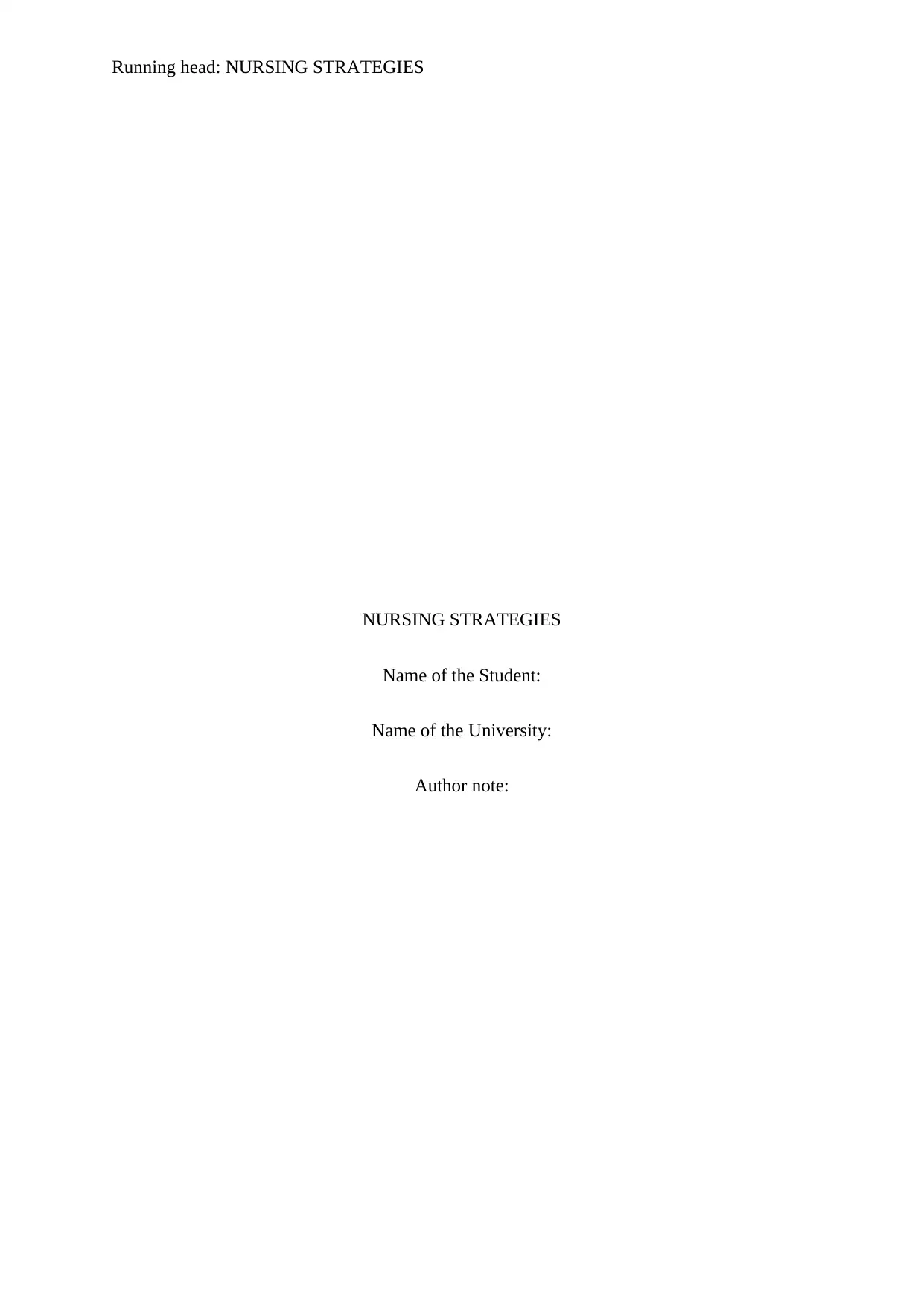
Running head: NURSING STRATEGIES
NURSING STRATEGIES
Name of the Student:
Name of the University:
Author note:
NURSING STRATEGIES
Name of the Student:
Name of the University:
Author note:
Paraphrase This Document
Need a fresh take? Get an instant paraphrase of this document with our AI Paraphraser
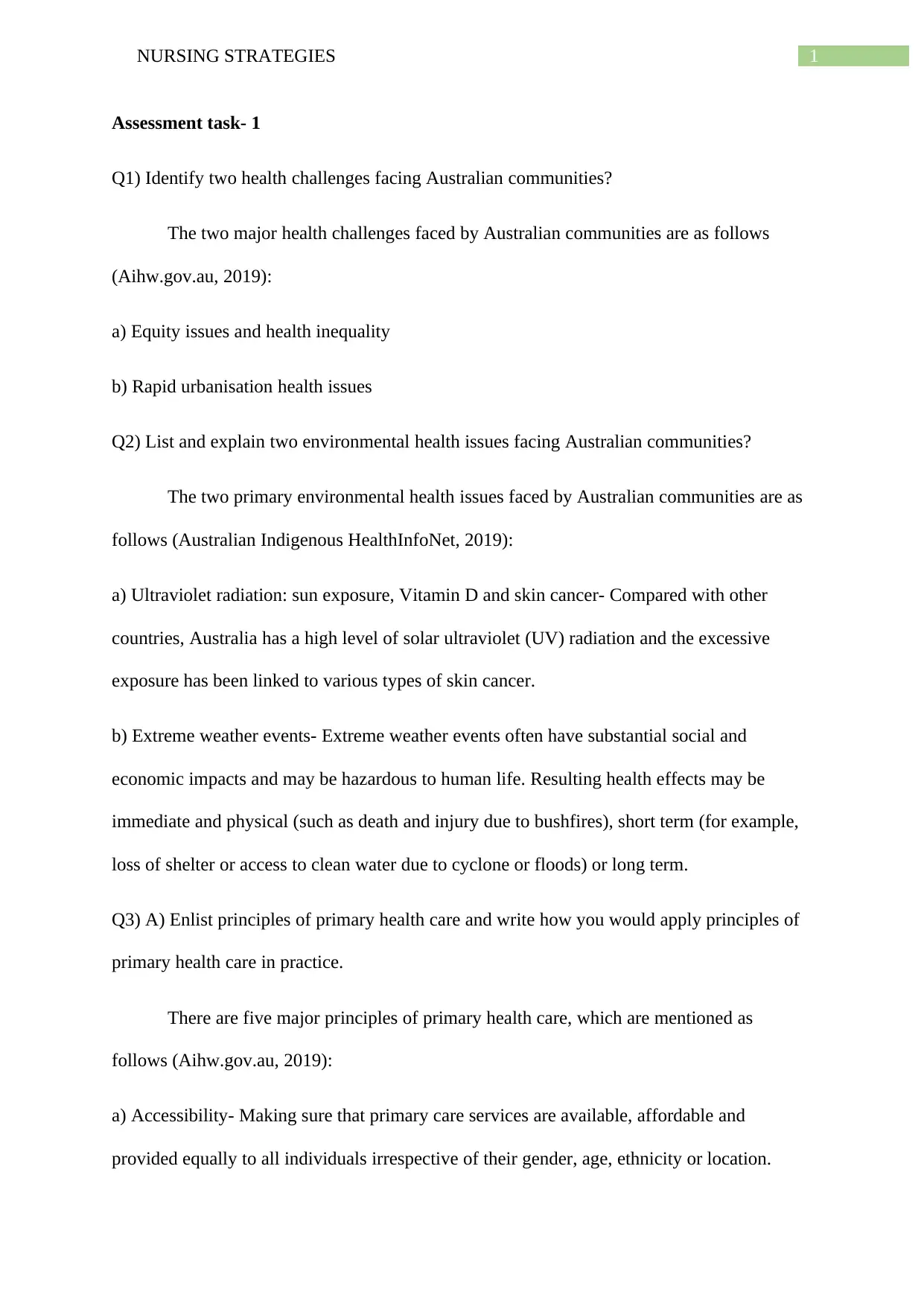
1NURSING STRATEGIES
Assessment task- 1
Q1) Identify two health challenges facing Australian communities?
The two major health challenges faced by Australian communities are as follows
(Aihw.gov.au, 2019):
a) Equity issues and health inequality
b) Rapid urbanisation health issues
Q2) List and explain two environmental health issues facing Australian communities?
The two primary environmental health issues faced by Australian communities are as
follows (Australian Indigenous HealthInfoNet, 2019):
a) Ultraviolet radiation: sun exposure, Vitamin D and skin cancer- Compared with other
countries, Australia has a high level of solar ultraviolet (UV) radiation and the excessive
exposure has been linked to various types of skin cancer.
b) Extreme weather events- Extreme weather events often have substantial social and
economic impacts and may be hazardous to human life. Resulting health effects may be
immediate and physical (such as death and injury due to bushfires), short term (for example,
loss of shelter or access to clean water due to cyclone or floods) or long term.
Q3) A) Enlist principles of primary health care and write how you would apply principles of
primary health care in practice.
There are five major principles of primary health care, which are mentioned as
follows (Aihw.gov.au, 2019):
a) Accessibility- Making sure that primary care services are available, affordable and
provided equally to all individuals irrespective of their gender, age, ethnicity or location.
Assessment task- 1
Q1) Identify two health challenges facing Australian communities?
The two major health challenges faced by Australian communities are as follows
(Aihw.gov.au, 2019):
a) Equity issues and health inequality
b) Rapid urbanisation health issues
Q2) List and explain two environmental health issues facing Australian communities?
The two primary environmental health issues faced by Australian communities are as
follows (Australian Indigenous HealthInfoNet, 2019):
a) Ultraviolet radiation: sun exposure, Vitamin D and skin cancer- Compared with other
countries, Australia has a high level of solar ultraviolet (UV) radiation and the excessive
exposure has been linked to various types of skin cancer.
b) Extreme weather events- Extreme weather events often have substantial social and
economic impacts and may be hazardous to human life. Resulting health effects may be
immediate and physical (such as death and injury due to bushfires), short term (for example,
loss of shelter or access to clean water due to cyclone or floods) or long term.
Q3) A) Enlist principles of primary health care and write how you would apply principles of
primary health care in practice.
There are five major principles of primary health care, which are mentioned as
follows (Aihw.gov.au, 2019):
a) Accessibility- Making sure that primary care services are available, affordable and
provided equally to all individuals irrespective of their gender, age, ethnicity or location.
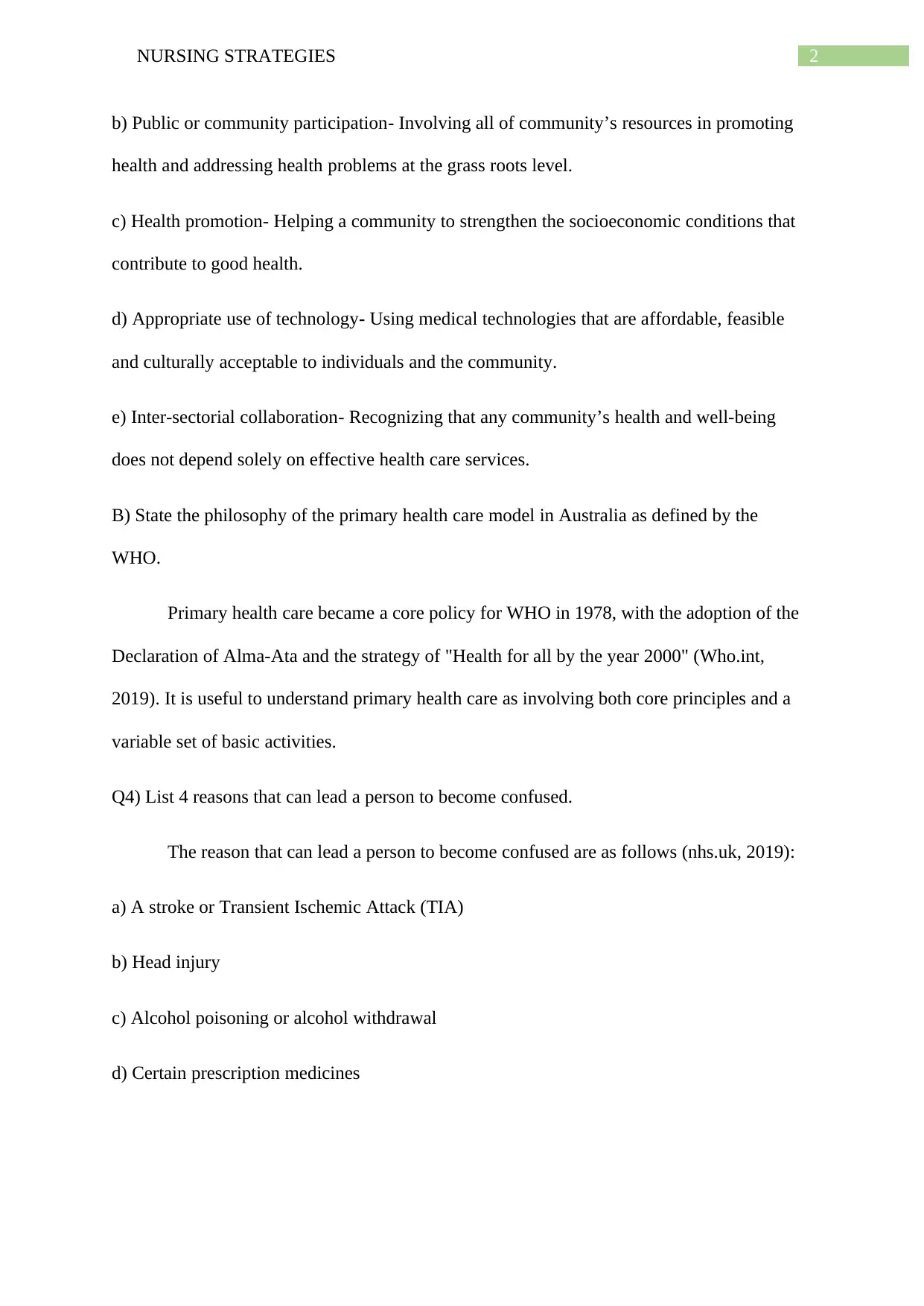
2NURSING STRATEGIES
b) Public or community participation- Involving all of community’s resources in promoting
health and addressing health problems at the grass roots level.
c) Health promotion- Helping a community to strengthen the socioeconomic conditions that
contribute to good health.
d) Appropriate use of technology- Using medical technologies that are affordable, feasible
and culturally acceptable to individuals and the community.
e) Inter-sectorial collaboration- Recognizing that any community’s health and well-being
does not depend solely on effective health care services.
B) State the philosophy of the primary health care model in Australia as defined by the
WHO.
Primary health care became a core policy for WHO in 1978, with the adoption of the
Declaration of Alma-Ata and the strategy of "Health for all by the year 2000" (Who.int,
2019). It is useful to understand primary health care as involving both core principles and a
variable set of basic activities.
Q4) List 4 reasons that can lead a person to become confused.
The reason that can lead a person to become confused are as follows (nhs.uk, 2019):
a) A stroke or Transient Ischemic Attack (TIA)
b) Head injury
c) Alcohol poisoning or alcohol withdrawal
d) Certain prescription medicines
b) Public or community participation- Involving all of community’s resources in promoting
health and addressing health problems at the grass roots level.
c) Health promotion- Helping a community to strengthen the socioeconomic conditions that
contribute to good health.
d) Appropriate use of technology- Using medical technologies that are affordable, feasible
and culturally acceptable to individuals and the community.
e) Inter-sectorial collaboration- Recognizing that any community’s health and well-being
does not depend solely on effective health care services.
B) State the philosophy of the primary health care model in Australia as defined by the
WHO.
Primary health care became a core policy for WHO in 1978, with the adoption of the
Declaration of Alma-Ata and the strategy of "Health for all by the year 2000" (Who.int,
2019). It is useful to understand primary health care as involving both core principles and a
variable set of basic activities.
Q4) List 4 reasons that can lead a person to become confused.
The reason that can lead a person to become confused are as follows (nhs.uk, 2019):
a) A stroke or Transient Ischemic Attack (TIA)
b) Head injury
c) Alcohol poisoning or alcohol withdrawal
d) Certain prescription medicines
⊘ This is a preview!⊘
Do you want full access?
Subscribe today to unlock all pages.

Trusted by 1+ million students worldwide
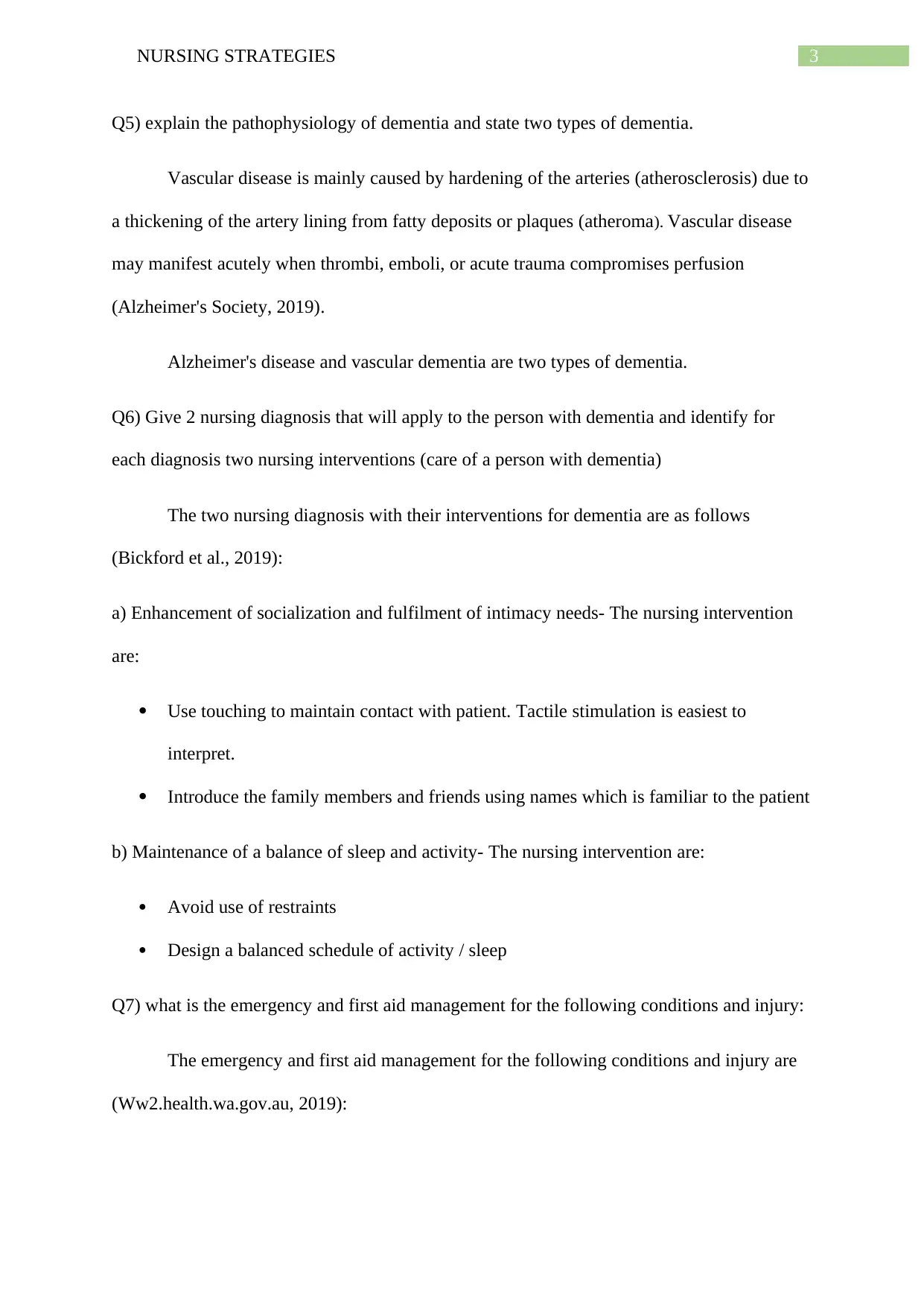
3NURSING STRATEGIES
Q5) explain the pathophysiology of dementia and state two types of dementia.
Vascular disease is mainly caused by hardening of the arteries (atherosclerosis) due to
a thickening of the artery lining from fatty deposits or plaques (atheroma). Vascular disease
may manifest acutely when thrombi, emboli, or acute trauma compromises perfusion
(Alzheimer's Society, 2019).
Alzheimer's disease and vascular dementia are two types of dementia.
Q6) Give 2 nursing diagnosis that will apply to the person with dementia and identify for
each diagnosis two nursing interventions (care of a person with dementia)
The two nursing diagnosis with their interventions for dementia are as follows
(Bickford et al., 2019):
a) Enhancement of socialization and fulfilment of intimacy needs- The nursing intervention
are:
Use touching to maintain contact with patient. Tactile stimulation is easiest to
interpret.
Introduce the family members and friends using names which is familiar to the patient
b) Maintenance of a balance of sleep and activity- The nursing intervention are:
Avoid use of restraints
Design a balanced schedule of activity / sleep
Q7) what is the emergency and first aid management for the following conditions and injury:
The emergency and first aid management for the following conditions and injury are
(Ww2.health.wa.gov.au, 2019):
Q5) explain the pathophysiology of dementia and state two types of dementia.
Vascular disease is mainly caused by hardening of the arteries (atherosclerosis) due to
a thickening of the artery lining from fatty deposits or plaques (atheroma). Vascular disease
may manifest acutely when thrombi, emboli, or acute trauma compromises perfusion
(Alzheimer's Society, 2019).
Alzheimer's disease and vascular dementia are two types of dementia.
Q6) Give 2 nursing diagnosis that will apply to the person with dementia and identify for
each diagnosis two nursing interventions (care of a person with dementia)
The two nursing diagnosis with their interventions for dementia are as follows
(Bickford et al., 2019):
a) Enhancement of socialization and fulfilment of intimacy needs- The nursing intervention
are:
Use touching to maintain contact with patient. Tactile stimulation is easiest to
interpret.
Introduce the family members and friends using names which is familiar to the patient
b) Maintenance of a balance of sleep and activity- The nursing intervention are:
Avoid use of restraints
Design a balanced schedule of activity / sleep
Q7) what is the emergency and first aid management for the following conditions and injury:
The emergency and first aid management for the following conditions and injury are
(Ww2.health.wa.gov.au, 2019):
Paraphrase This Document
Need a fresh take? Get an instant paraphrase of this document with our AI Paraphraser
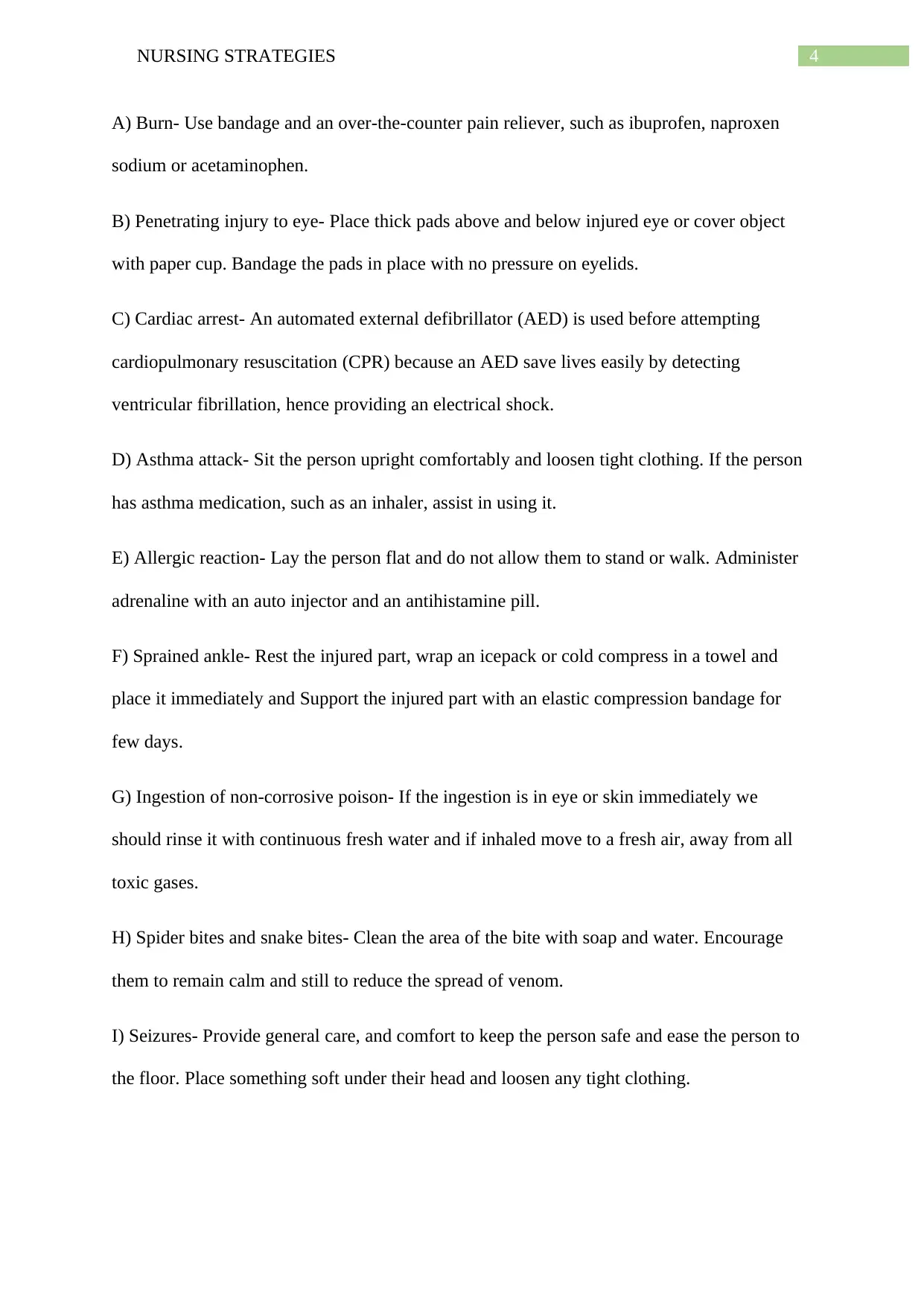
4NURSING STRATEGIES
A) Burn- Use bandage and an over-the-counter pain reliever, such as ibuprofen, naproxen
sodium or acetaminophen.
B) Penetrating injury to eye- Place thick pads above and below injured eye or cover object
with paper cup. Bandage the pads in place with no pressure on eyelids.
C) Cardiac arrest- An automated external defibrillator (AED) is used before attempting
cardiopulmonary resuscitation (CPR) because an AED save lives easily by detecting
ventricular fibrillation, hence providing an electrical shock.
D) Asthma attack- Sit the person upright comfortably and loosen tight clothing. If the person
has asthma medication, such as an inhaler, assist in using it.
E) Allergic reaction- Lay the person flat and do not allow them to stand or walk. Administer
adrenaline with an auto injector and an antihistamine pill.
F) Sprained ankle- Rest the injured part, wrap an icepack or cold compress in a towel and
place it immediately and Support the injured part with an elastic compression bandage for
few days.
G) Ingestion of non-corrosive poison- If the ingestion is in eye or skin immediately we
should rinse it with continuous fresh water and if inhaled move to a fresh air, away from all
toxic gases.
H) Spider bites and snake bites- Clean the area of the bite with soap and water. Encourage
them to remain calm and still to reduce the spread of venom.
I) Seizures- Provide general care, and comfort to keep the person safe and ease the person to
the floor. Place something soft under their head and loosen any tight clothing.
A) Burn- Use bandage and an over-the-counter pain reliever, such as ibuprofen, naproxen
sodium or acetaminophen.
B) Penetrating injury to eye- Place thick pads above and below injured eye or cover object
with paper cup. Bandage the pads in place with no pressure on eyelids.
C) Cardiac arrest- An automated external defibrillator (AED) is used before attempting
cardiopulmonary resuscitation (CPR) because an AED save lives easily by detecting
ventricular fibrillation, hence providing an electrical shock.
D) Asthma attack- Sit the person upright comfortably and loosen tight clothing. If the person
has asthma medication, such as an inhaler, assist in using it.
E) Allergic reaction- Lay the person flat and do not allow them to stand or walk. Administer
adrenaline with an auto injector and an antihistamine pill.
F) Sprained ankle- Rest the injured part, wrap an icepack or cold compress in a towel and
place it immediately and Support the injured part with an elastic compression bandage for
few days.
G) Ingestion of non-corrosive poison- If the ingestion is in eye or skin immediately we
should rinse it with continuous fresh water and if inhaled move to a fresh air, away from all
toxic gases.
H) Spider bites and snake bites- Clean the area of the bite with soap and water. Encourage
them to remain calm and still to reduce the spread of venom.
I) Seizures- Provide general care, and comfort to keep the person safe and ease the person to
the floor. Place something soft under their head and loosen any tight clothing.
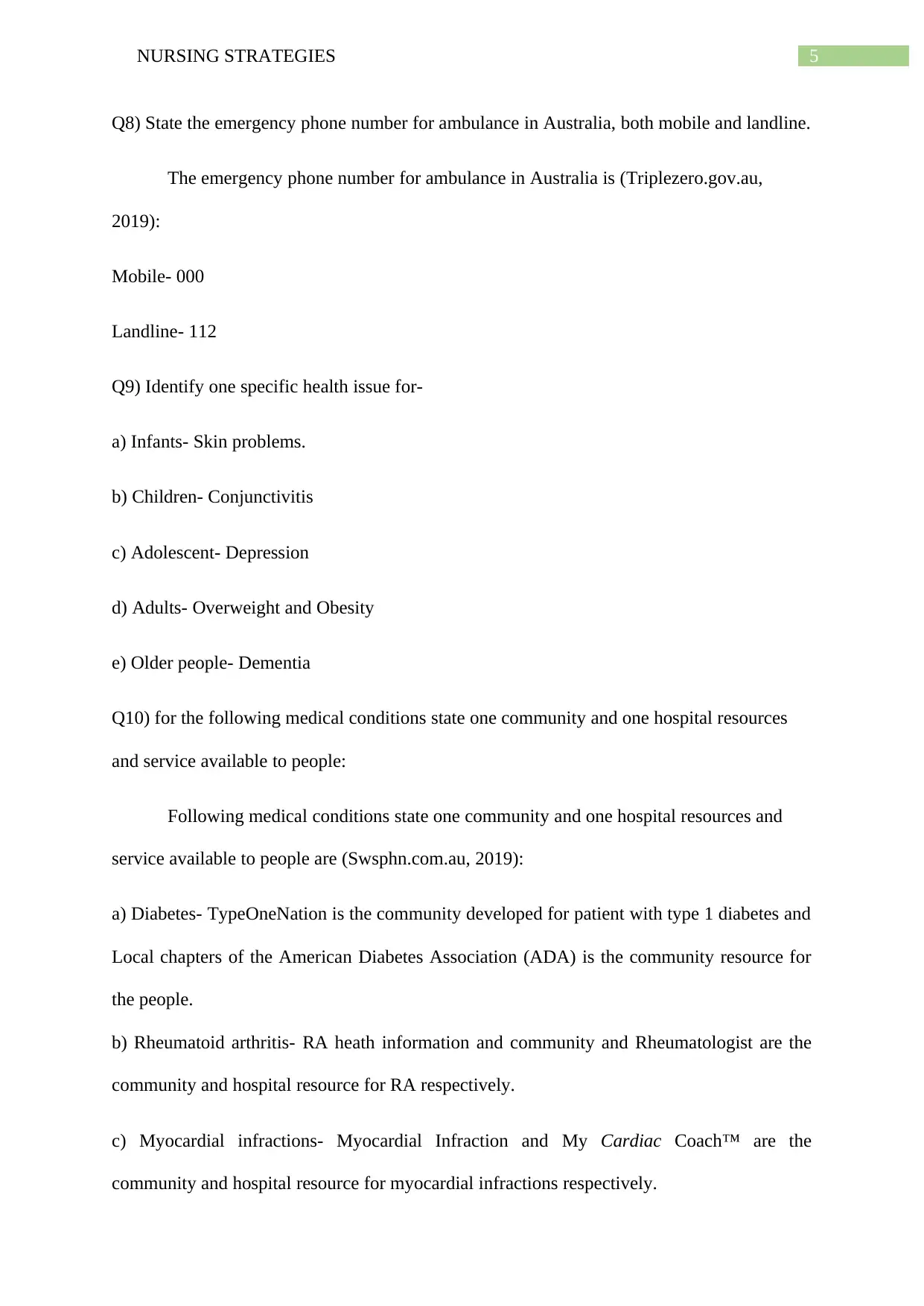
5NURSING STRATEGIES
Q8) State the emergency phone number for ambulance in Australia, both mobile and landline.
The emergency phone number for ambulance in Australia is (Triplezero.gov.au,
2019):
Mobile- 000
Landline- 112
Q9) Identify one specific health issue for-
a) Infants- Skin problems.
b) Children- Conjunctivitis
c) Adolescent- Depression
d) Adults- Overweight and Obesity
e) Older people- Dementia
Q10) for the following medical conditions state one community and one hospital resources
and service available to people:
Following medical conditions state one community and one hospital resources and
service available to people are (Swsphn.com.au, 2019):
a) Diabetes- TypeOneNation is the community developed for patient with type 1 diabetes and
Local chapters of the American Diabetes Association (ADA) is the community resource for
the people.
b) Rheumatoid arthritis- RA heath information and community and Rheumatologist are the
community and hospital resource for RA respectively.
c) Myocardial infractions- Myocardial Infraction and My Cardiac Coach™ are the
community and hospital resource for myocardial infractions respectively.
Q8) State the emergency phone number for ambulance in Australia, both mobile and landline.
The emergency phone number for ambulance in Australia is (Triplezero.gov.au,
2019):
Mobile- 000
Landline- 112
Q9) Identify one specific health issue for-
a) Infants- Skin problems.
b) Children- Conjunctivitis
c) Adolescent- Depression
d) Adults- Overweight and Obesity
e) Older people- Dementia
Q10) for the following medical conditions state one community and one hospital resources
and service available to people:
Following medical conditions state one community and one hospital resources and
service available to people are (Swsphn.com.au, 2019):
a) Diabetes- TypeOneNation is the community developed for patient with type 1 diabetes and
Local chapters of the American Diabetes Association (ADA) is the community resource for
the people.
b) Rheumatoid arthritis- RA heath information and community and Rheumatologist are the
community and hospital resource for RA respectively.
c) Myocardial infractions- Myocardial Infraction and My Cardiac Coach™ are the
community and hospital resource for myocardial infractions respectively.
⊘ This is a preview!⊘
Do you want full access?
Subscribe today to unlock all pages.

Trusted by 1+ million students worldwide
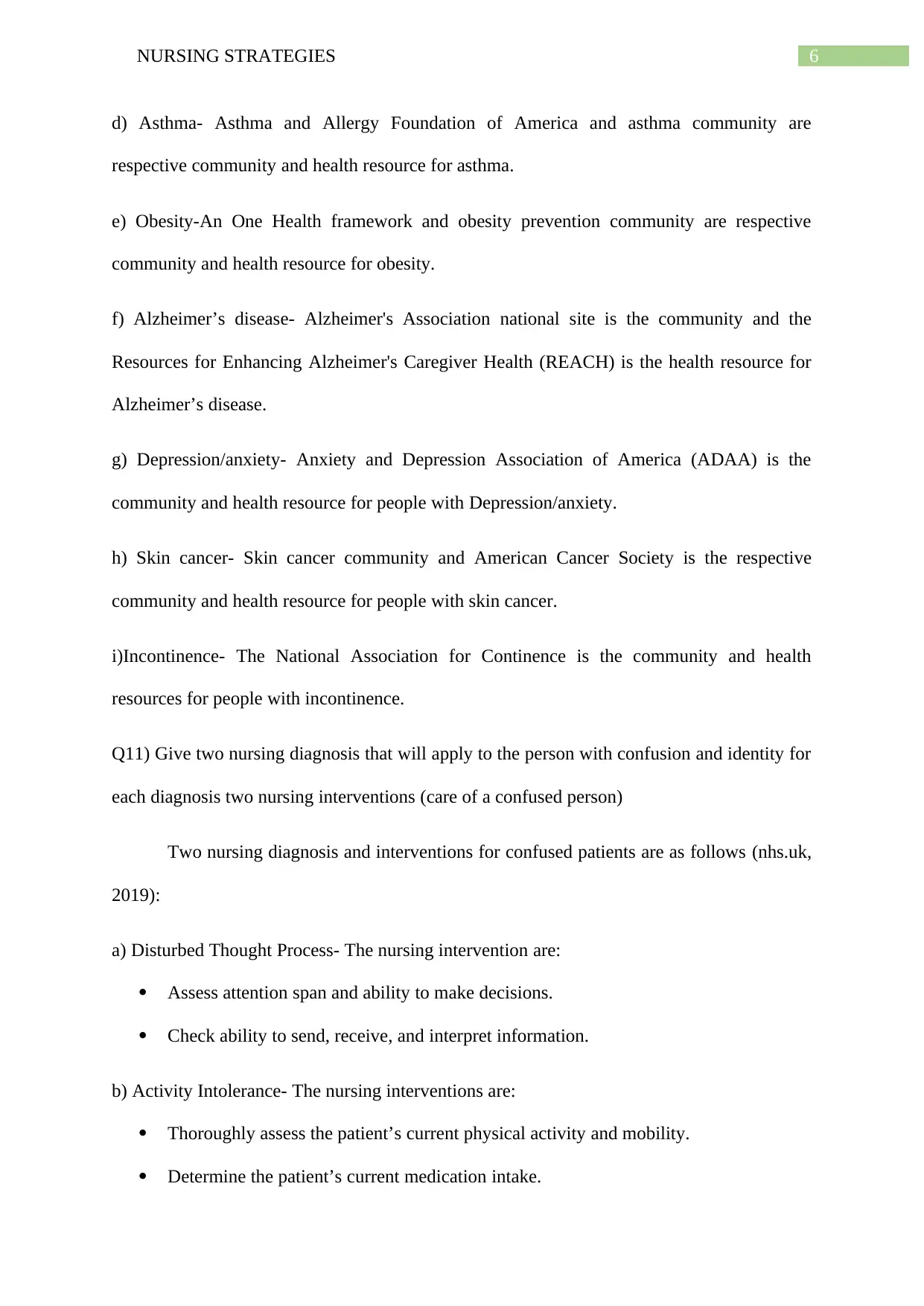
6NURSING STRATEGIES
d) Asthma- Asthma and Allergy Foundation of America and asthma community are
respective community and health resource for asthma.
e) Obesity-An One Health framework and obesity prevention community are respective
community and health resource for obesity.
f) Alzheimer’s disease- Alzheimer's Association national site is the community and the
Resources for Enhancing Alzheimer's Caregiver Health (REACH) is the health resource for
Alzheimer’s disease.
g) Depression/anxiety- Anxiety and Depression Association of America (ADAA) is the
community and health resource for people with Depression/anxiety.
h) Skin cancer- Skin cancer community and American Cancer Society is the respective
community and health resource for people with skin cancer.
i)Incontinence- The National Association for Continence is the community and health
resources for people with incontinence.
Q11) Give two nursing diagnosis that will apply to the person with confusion and identity for
each diagnosis two nursing interventions (care of a confused person)
Two nursing diagnosis and interventions for confused patients are as follows (nhs.uk,
2019):
a) Disturbed Thought Process- The nursing intervention are:
Assess attention span and ability to make decisions.
Check ability to send, receive, and interpret information.
b) Activity Intolerance- The nursing interventions are:
Thoroughly assess the patient’s current physical activity and mobility.
Determine the patient’s current medication intake.
d) Asthma- Asthma and Allergy Foundation of America and asthma community are
respective community and health resource for asthma.
e) Obesity-An One Health framework and obesity prevention community are respective
community and health resource for obesity.
f) Alzheimer’s disease- Alzheimer's Association national site is the community and the
Resources for Enhancing Alzheimer's Caregiver Health (REACH) is the health resource for
Alzheimer’s disease.
g) Depression/anxiety- Anxiety and Depression Association of America (ADAA) is the
community and health resource for people with Depression/anxiety.
h) Skin cancer- Skin cancer community and American Cancer Society is the respective
community and health resource for people with skin cancer.
i)Incontinence- The National Association for Continence is the community and health
resources for people with incontinence.
Q11) Give two nursing diagnosis that will apply to the person with confusion and identity for
each diagnosis two nursing interventions (care of a confused person)
Two nursing diagnosis and interventions for confused patients are as follows (nhs.uk,
2019):
a) Disturbed Thought Process- The nursing intervention are:
Assess attention span and ability to make decisions.
Check ability to send, receive, and interpret information.
b) Activity Intolerance- The nursing interventions are:
Thoroughly assess the patient’s current physical activity and mobility.
Determine the patient’s current medication intake.
Paraphrase This Document
Need a fresh take? Get an instant paraphrase of this document with our AI Paraphraser
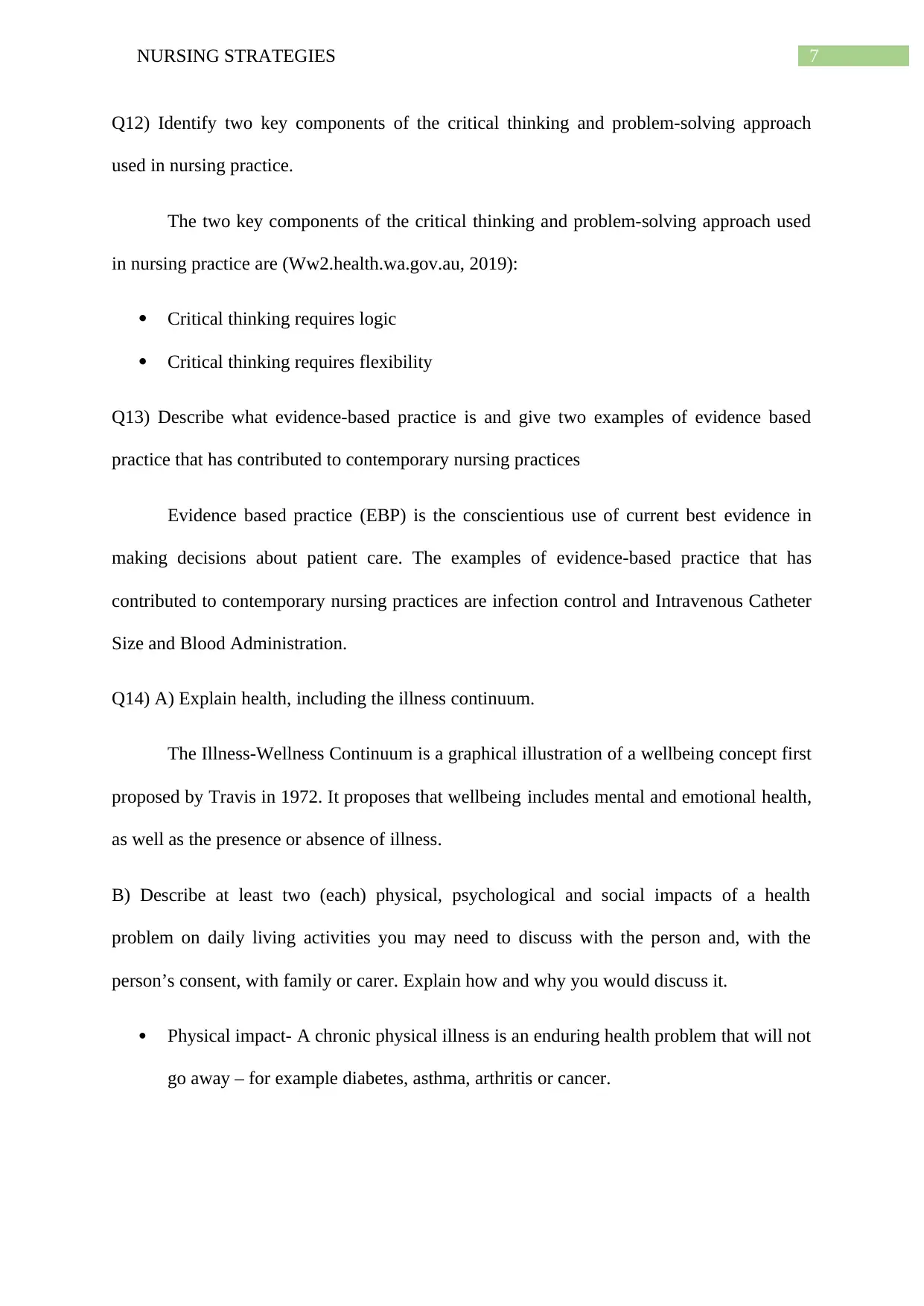
7NURSING STRATEGIES
Q12) Identify two key components of the critical thinking and problem-solving approach
used in nursing practice.
The two key components of the critical thinking and problem-solving approach used
in nursing practice are (Ww2.health.wa.gov.au, 2019):
Critical thinking requires logic
Critical thinking requires flexibility
Q13) Describe what evidence-based practice is and give two examples of evidence based
practice that has contributed to contemporary nursing practices
Evidence based practice (EBP) is the conscientious use of current best evidence in
making decisions about patient care. The examples of evidence-based practice that has
contributed to contemporary nursing practices are infection control and Intravenous Catheter
Size and Blood Administration.
Q14) A) Explain health, including the illness continuum.
The Illness-Wellness Continuum is a graphical illustration of a wellbeing concept first
proposed by Travis in 1972. It proposes that wellbeing includes mental and emotional health,
as well as the presence or absence of illness.
B) Describe at least two (each) physical, psychological and social impacts of a health
problem on daily living activities you may need to discuss with the person and, with the
person’s consent, with family or carer. Explain how and why you would discuss it.
Physical impact- A chronic physical illness is an enduring health problem that will not
go away – for example diabetes, asthma, arthritis or cancer.
Q12) Identify two key components of the critical thinking and problem-solving approach
used in nursing practice.
The two key components of the critical thinking and problem-solving approach used
in nursing practice are (Ww2.health.wa.gov.au, 2019):
Critical thinking requires logic
Critical thinking requires flexibility
Q13) Describe what evidence-based practice is and give two examples of evidence based
practice that has contributed to contemporary nursing practices
Evidence based practice (EBP) is the conscientious use of current best evidence in
making decisions about patient care. The examples of evidence-based practice that has
contributed to contemporary nursing practices are infection control and Intravenous Catheter
Size and Blood Administration.
Q14) A) Explain health, including the illness continuum.
The Illness-Wellness Continuum is a graphical illustration of a wellbeing concept first
proposed by Travis in 1972. It proposes that wellbeing includes mental and emotional health,
as well as the presence or absence of illness.
B) Describe at least two (each) physical, psychological and social impacts of a health
problem on daily living activities you may need to discuss with the person and, with the
person’s consent, with family or carer. Explain how and why you would discuss it.
Physical impact- A chronic physical illness is an enduring health problem that will not
go away – for example diabetes, asthma, arthritis or cancer.
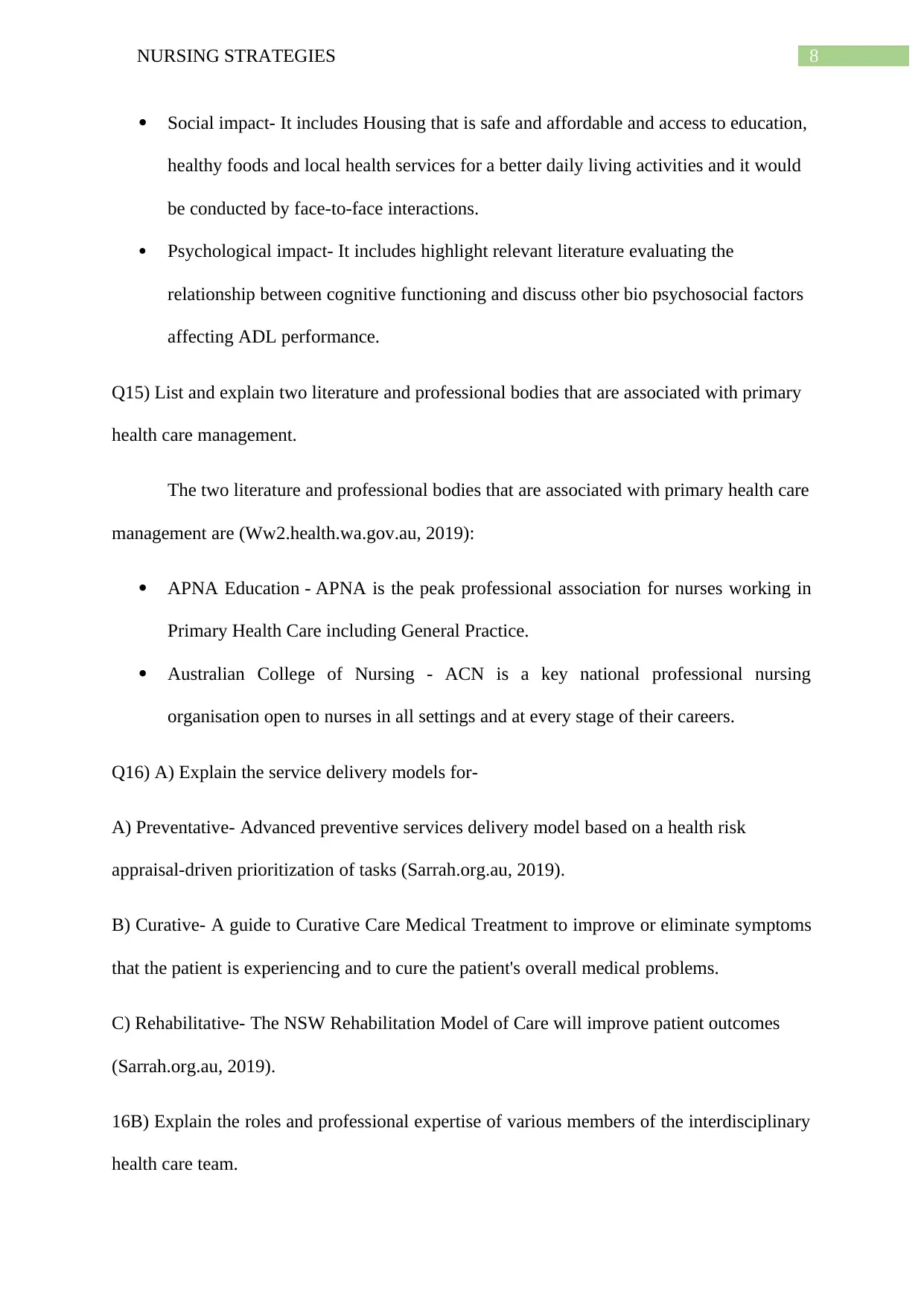
8NURSING STRATEGIES
Social impact- It includes Housing that is safe and affordable and access to education,
healthy foods and local health services for a better daily living activities and it would
be conducted by face-to-face interactions.
Psychological impact- It includes highlight relevant literature evaluating the
relationship between cognitive functioning and discuss other bio psychosocial factors
affecting ADL performance.
Q15) List and explain two literature and professional bodies that are associated with primary
health care management.
The two literature and professional bodies that are associated with primary health care
management are (Ww2.health.wa.gov.au, 2019):
APNA Education - APNA is the peak professional association for nurses working in
Primary Health Care including General Practice.
Australian College of Nursing - ACN is a key national professional nursing
organisation open to nurses in all settings and at every stage of their careers.
Q16) A) Explain the service delivery models for-
A) Preventative- Advanced preventive services delivery model based on a health risk
appraisal-driven prioritization of tasks (Sarrah.org.au, 2019).
B) Curative- A guide to Curative Care Medical Treatment to improve or eliminate symptoms
that the patient is experiencing and to cure the patient's overall medical problems.
C) Rehabilitative- The NSW Rehabilitation Model of Care will improve patient outcomes
(Sarrah.org.au, 2019).
16B) Explain the roles and professional expertise of various members of the interdisciplinary
health care team.
Social impact- It includes Housing that is safe and affordable and access to education,
healthy foods and local health services for a better daily living activities and it would
be conducted by face-to-face interactions.
Psychological impact- It includes highlight relevant literature evaluating the
relationship between cognitive functioning and discuss other bio psychosocial factors
affecting ADL performance.
Q15) List and explain two literature and professional bodies that are associated with primary
health care management.
The two literature and professional bodies that are associated with primary health care
management are (Ww2.health.wa.gov.au, 2019):
APNA Education - APNA is the peak professional association for nurses working in
Primary Health Care including General Practice.
Australian College of Nursing - ACN is a key national professional nursing
organisation open to nurses in all settings and at every stage of their careers.
Q16) A) Explain the service delivery models for-
A) Preventative- Advanced preventive services delivery model based on a health risk
appraisal-driven prioritization of tasks (Sarrah.org.au, 2019).
B) Curative- A guide to Curative Care Medical Treatment to improve or eliminate symptoms
that the patient is experiencing and to cure the patient's overall medical problems.
C) Rehabilitative- The NSW Rehabilitation Model of Care will improve patient outcomes
(Sarrah.org.au, 2019).
16B) Explain the roles and professional expertise of various members of the interdisciplinary
health care team.
⊘ This is a preview!⊘
Do you want full access?
Subscribe today to unlock all pages.

Trusted by 1+ million students worldwide
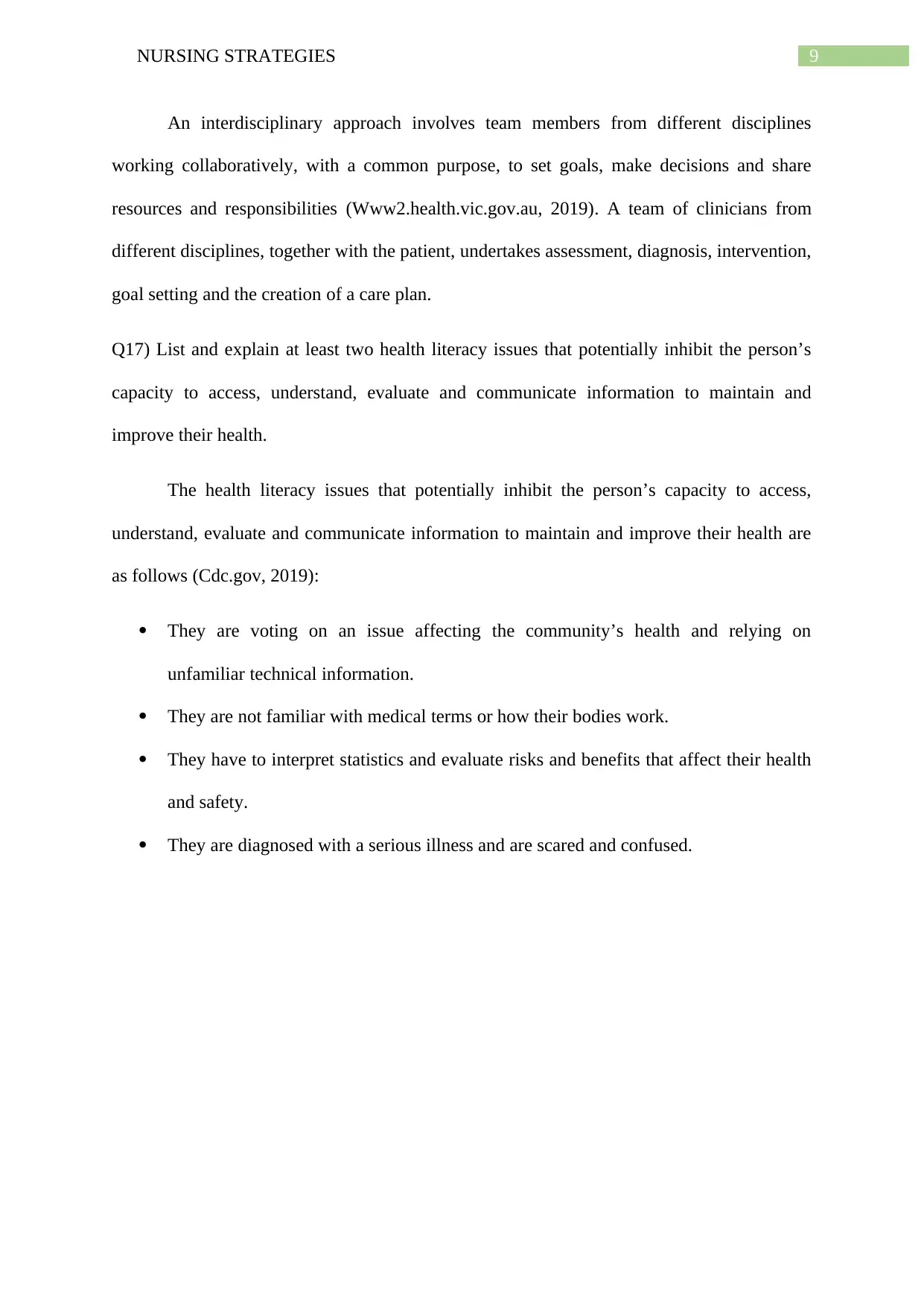
9NURSING STRATEGIES
An interdisciplinary approach involves team members from different disciplines
working collaboratively, with a common purpose, to set goals, make decisions and share
resources and responsibilities (Www2.health.vic.gov.au, 2019). A team of clinicians from
different disciplines, together with the patient, undertakes assessment, diagnosis, intervention,
goal setting and the creation of a care plan.
Q17) List and explain at least two health literacy issues that potentially inhibit the person’s
capacity to access, understand, evaluate and communicate information to maintain and
improve their health.
The health literacy issues that potentially inhibit the person’s capacity to access,
understand, evaluate and communicate information to maintain and improve their health are
as follows (Cdc.gov, 2019):
They are voting on an issue affecting the community’s health and relying on
unfamiliar technical information.
They are not familiar with medical terms or how their bodies work.
They have to interpret statistics and evaluate risks and benefits that affect their health
and safety.
They are diagnosed with a serious illness and are scared and confused.
An interdisciplinary approach involves team members from different disciplines
working collaboratively, with a common purpose, to set goals, make decisions and share
resources and responsibilities (Www2.health.vic.gov.au, 2019). A team of clinicians from
different disciplines, together with the patient, undertakes assessment, diagnosis, intervention,
goal setting and the creation of a care plan.
Q17) List and explain at least two health literacy issues that potentially inhibit the person’s
capacity to access, understand, evaluate and communicate information to maintain and
improve their health.
The health literacy issues that potentially inhibit the person’s capacity to access,
understand, evaluate and communicate information to maintain and improve their health are
as follows (Cdc.gov, 2019):
They are voting on an issue affecting the community’s health and relying on
unfamiliar technical information.
They are not familiar with medical terms or how their bodies work.
They have to interpret statistics and evaluate risks and benefits that affect their health
and safety.
They are diagnosed with a serious illness and are scared and confused.
Paraphrase This Document
Need a fresh take? Get an instant paraphrase of this document with our AI Paraphraser
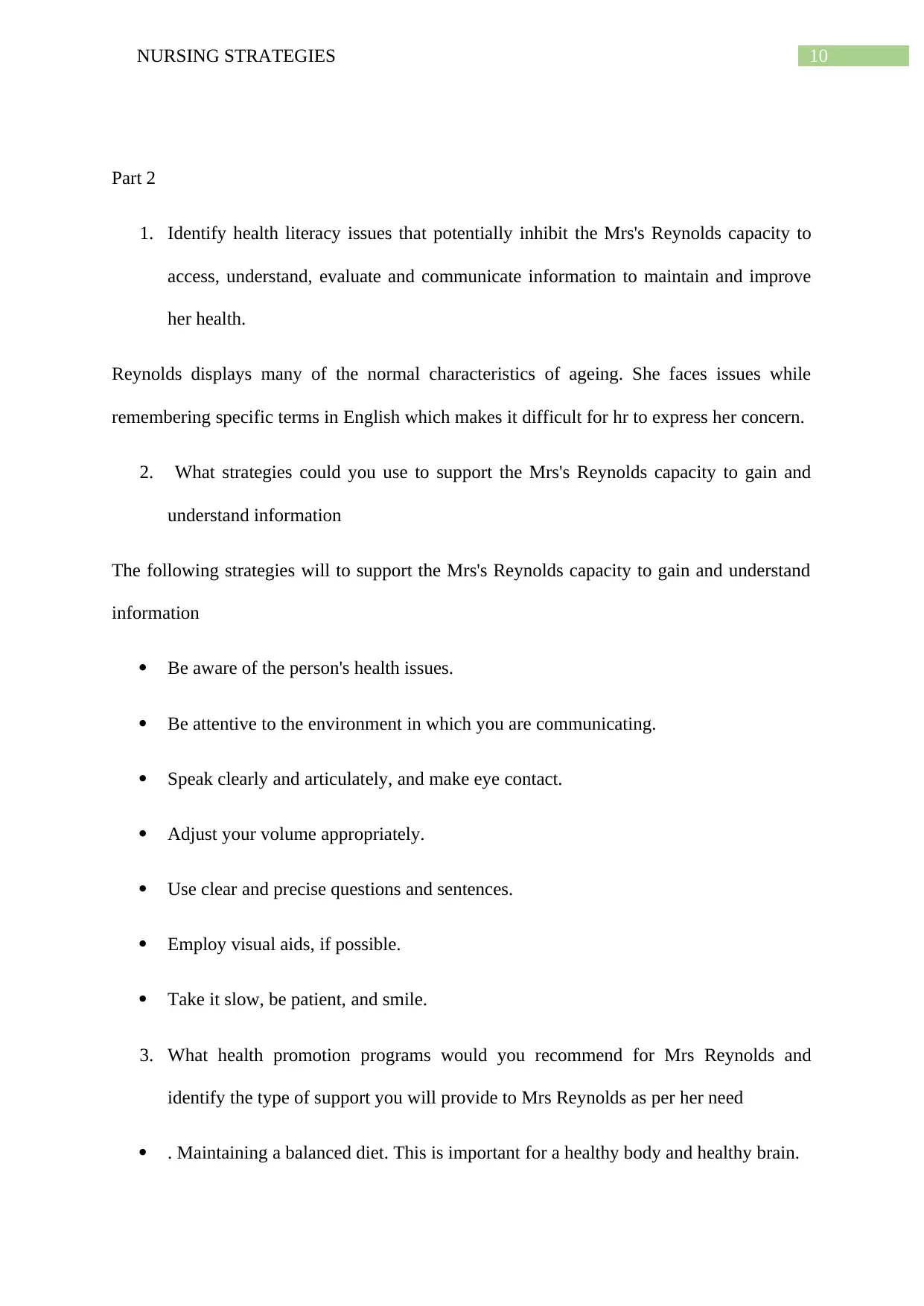
10NURSING STRATEGIES
Part 2
1. Identify health literacy issues that potentially inhibit the Mrs's Reynolds capacity to
access, understand, evaluate and communicate information to maintain and improve
her health.
Reynolds displays many of the normal characteristics of ageing. She faces issues while
remembering specific terms in English which makes it difficult for hr to express her concern.
2. What strategies could you use to support the Mrs's Reynolds capacity to gain and
understand information
The following strategies will to support the Mrs's Reynolds capacity to gain and understand
information
Be aware of the person's health issues.
Be attentive to the environment in which you are communicating.
Speak clearly and articulately, and make eye contact.
Adjust your volume appropriately.
Use clear and precise questions and sentences.
Employ visual aids, if possible.
Take it slow, be patient, and smile.
3. What health promotion programs would you recommend for Mrs Reynolds and
identify the type of support you will provide to Mrs Reynolds as per her need
. Maintaining a balanced diet. This is important for a healthy body and healthy brain.
Part 2
1. Identify health literacy issues that potentially inhibit the Mrs's Reynolds capacity to
access, understand, evaluate and communicate information to maintain and improve
her health.
Reynolds displays many of the normal characteristics of ageing. She faces issues while
remembering specific terms in English which makes it difficult for hr to express her concern.
2. What strategies could you use to support the Mrs's Reynolds capacity to gain and
understand information
The following strategies will to support the Mrs's Reynolds capacity to gain and understand
information
Be aware of the person's health issues.
Be attentive to the environment in which you are communicating.
Speak clearly and articulately, and make eye contact.
Adjust your volume appropriately.
Use clear and precise questions and sentences.
Employ visual aids, if possible.
Take it slow, be patient, and smile.
3. What health promotion programs would you recommend for Mrs Reynolds and
identify the type of support you will provide to Mrs Reynolds as per her need
. Maintaining a balanced diet. This is important for a healthy body and healthy brain.
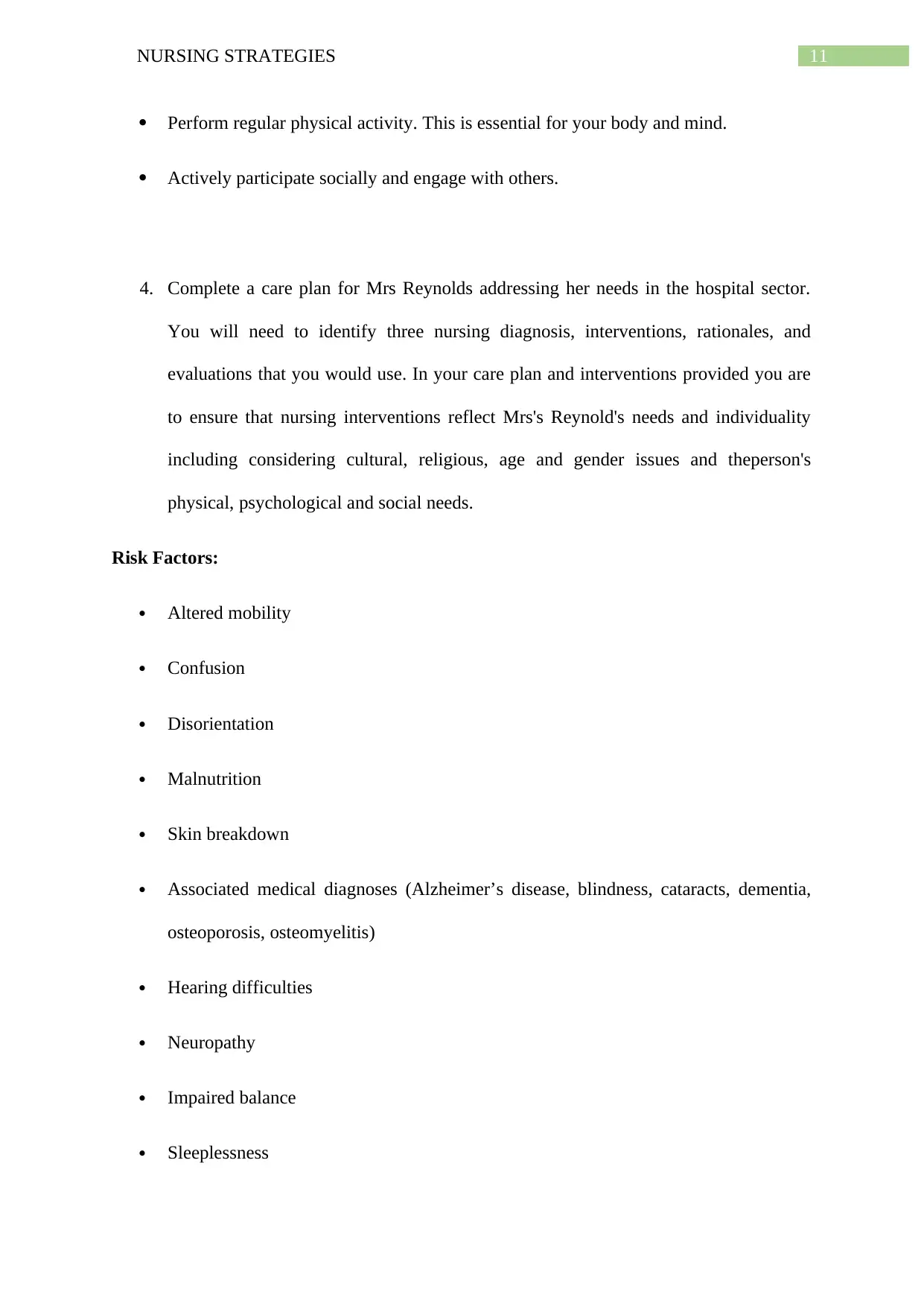
11NURSING STRATEGIES
Perform regular physical activity. This is essential for your body and mind.
Actively participate socially and engage with others.
4. Complete a care plan for Mrs Reynolds addressing her needs in the hospital sector.
You will need to identify three nursing diagnosis, interventions, rationales, and
evaluations that you would use. In your care plan and interventions provided you are
to ensure that nursing interventions reflect Mrs's Reynold's needs and individuality
including considering cultural, religious, age and gender issues and theperson's
physical, psychological and social needs.
Risk Factors:
Altered mobility
Confusion
Disorientation
Malnutrition
Skin breakdown
Associated medical diagnoses (Alzheimer’s disease, blindness, cataracts, dementia,
osteoporosis, osteomyelitis)
Hearing difficulties
Neuropathy
Impaired balance
Sleeplessness
Perform regular physical activity. This is essential for your body and mind.
Actively participate socially and engage with others.
4. Complete a care plan for Mrs Reynolds addressing her needs in the hospital sector.
You will need to identify three nursing diagnosis, interventions, rationales, and
evaluations that you would use. In your care plan and interventions provided you are
to ensure that nursing interventions reflect Mrs's Reynold's needs and individuality
including considering cultural, religious, age and gender issues and theperson's
physical, psychological and social needs.
Risk Factors:
Altered mobility
Confusion
Disorientation
Malnutrition
Skin breakdown
Associated medical diagnoses (Alzheimer’s disease, blindness, cataracts, dementia,
osteoporosis, osteomyelitis)
Hearing difficulties
Neuropathy
Impaired balance
Sleeplessness
⊘ This is a preview!⊘
Do you want full access?
Subscribe today to unlock all pages.

Trusted by 1+ million students worldwide
1 out of 18
Related Documents
Your All-in-One AI-Powered Toolkit for Academic Success.
+13062052269
info@desklib.com
Available 24*7 on WhatsApp / Email
![[object Object]](/_next/static/media/star-bottom.7253800d.svg)
Unlock your academic potential
Copyright © 2020–2025 A2Z Services. All Rights Reserved. Developed and managed by ZUCOL.




